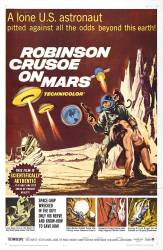Visible crew/equipment: Paul Mantee's helmet reflects two stage lights often when he is supposedly outside.

Robinson Crusoe On Mars (1964)
1 visible crew/equipment mistake - chronological order
Directed by: Byron Haskin
Starring: Adam West, Paul Mantee, The Woolly Monkey, Victor Lundin
Genres: Sci-fi
Continuity mistake: While avoiding the glowing meteoroid, they decide to fire their jets to push them into a higher orbit. In a couple of scenes they go up but a third one has them going back down.
Question: Was Robinson Crusoe On Mars scientifically plausible when it was made in 1964? Aged eight, I watched this movie on release. Even then I knew it was a movie, not a scientific documentary. Nevertheless, I understand that it was once seriously believed there were canals on the surface of Mars. (I even had a children's pictorial encyclopaedia which showed Mars criss-crossed by canals.) After crash-landing on Mars astronaut Kit Draper (Paul Mantee) discovers that the Martian canals were made by intelligent, technologically advanced beings millennia ago. Could anybody in the scientific community have believed this in 1964? Kit Draper discovers ways of creating oxygen, so he does not suffocate; he then finds water sources, vegetation he can eat and a coal like rock that burns to make fires. He witnesses extra-terrestrial aliens visiting Mars in space ships. Was this, by any stretch of the imagination, regarded as even remotely credible in 1964? Or was it pure Hollywood hokum?
Join the mailing list
Separate from membership, this is to get updates about mistakes in recent releases. Addresses are not passed on to any third party, and are used solely for direct communication from this site. You can unsubscribe at any time.
Check out the mistake & trivia books, on Kindle and in paperback.




Answer: This is pure Hollywood fiction, never meant to be science-based fact, and was typical of sci-fi films of that era such as: War of the Worlds, Invaders From Mars, The Martian Chronicles, and others. Many were based on early-to-mid-20th century science-fiction novels when little was scientifically known about any of the planets. Authors imagined what Mars was like purely to entertain readers. After the 1960s, as more was scientifically known about Mars, films became more realistic, although the 2012 Disney film, "John Carter," was a deliberate throwback to that earlier genre. Also, scientists never believed that there were canals on Mars. In the 1870s, Italian astronomer Giovanni Schiaparelli was mapping Mars through a telescope. He described the long, trench-like geographical features as "canali," (Italian for channels). American astronomer Percival Lowell misinterpreted this as "canals" and believed they were of intelligent origin, though other scientists debunked that. Sci-fi writers of the time (H.G. Wells, Edgar Rice Boroughs, et al) incorporated Lowell's published theories into their stories.
raywest ★
It should be noted "John Carter" is based on the 1912 novel "A Princess of Mars."
Bishop73